Related Research Articles

Magdalena Carmen Frida Kahlo y Calderón was a Mexican painter known for her many portraits, self-portraits, and works inspired by the nature and artifacts of Mexico. Inspired by the country's popular culture, she employed a naïve folk art style to explore questions of identity, postcolonialism, gender, class, and race in Mexican society. Her paintings often had strong autobiographical elements and mixed realism with fantasy. In addition to belonging to the post-revolutionary Mexicayotl movement, which sought to define a Mexican identity, Kahlo has been described as a surrealist or magical realist. She is also known for painting about her experience of chronic pain.

Judy Chicago is an American feminist artist, art educator, and writer known for her large collaborative art installation pieces about birth and creation images, which examine the role of women in history and culture. During the 1970s, Chicago founded the first feminist art program in the United States at California State University, Fresno which acted as a catalyst for feminist art and art education during the 1970s. Her inclusion in hundreds of publications in various areas of the world showcases her influence in the worldwide art community. Additionally, many of her books have been published in other countries, making her work more accessible to international readers. Chicago's work incorporates a variety of artistic skills, such as needlework, counterbalanced with skills such as welding and pyrotechnics. Her most well-known work is The Dinner Party, which is permanently installed in the Elizabeth A. Sackler Center for Feminist Art at the Brooklyn Museum. The Dinner Party celebrates the accomplishments of women throughout history and is widely regarded as the first epic feminist artwork. Other notable art projects by Chicago include International Honor Quilt, Birth Project, Powerplay, and The Holocaust Project. She is represented by Jessica Silverman gallery.
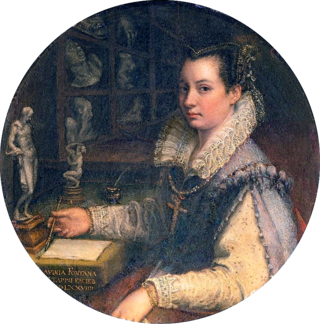
Lavinia Fontana was an Italian Mannerist painter active in Bologna and Rome. She is best known for her successful portraiture, but also worked in the genres of mythology and religious painting. She was trained by her father, Prospero Fontana. She is regarded as the first female career artist in Western Europe, as she relied on commissions for her income. Her family relied on her career as a painter, and her husband served as her agent and raised their 11 children. She was perhaps the first female artist to paint female nudes, but this is a topic of controversy among art historians.
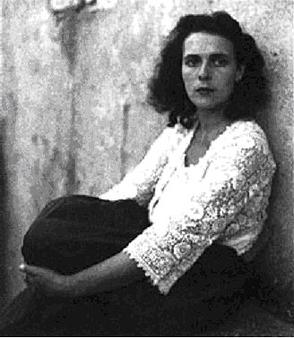
Mary Leonora Carrington was a British-born, naturalized Mexican surrealist painter and novelist. She lived most of her adult life in Mexico City and was one of the last surviving participants in the surrealist movement of the 1930s. Carrington was also a founding member of the women's liberation movement in Mexico during the 1970s.
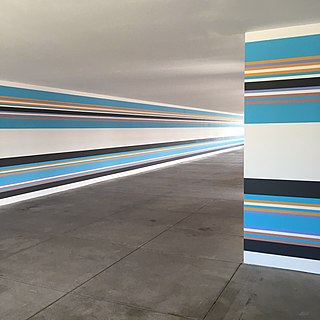
The absence of women from the canon of Western art has been a subject of inquiry and reconsideration since the early 1970s. Linda Nochlin's influential 1971 essay, "Why Have There Been No Great Women Artists?", examined the social and institutional barriers that blocked most women from entering artistic professions throughout history, prompted a new focus on women artists, their art and experiences, and contributed inspiration to the Feminist art movement. Although women artists have been involved in the making of art throughout history, their work, when compared to that of their male counterparts, has been often obfuscated, overlooked and undervalued. The Western canon has historically valued men's work over women's and attached gendered stereotypes to certain media, such as textile or fiber arts, to be primarily associated with women.

Iaia of Cyzicus, sometimes (incorrectly) called Lala or Lalla, or rendered as Laia or Maia, was a Greek painter born in Cyzicus, Roman Empire, and relatively exceptional for being a woman artist and painting women's portraits. She was alive during the time of Marcus Terentius Varro. In De Mulieribus Claris, his book of women's biographies, Boccaccio refers to her as "Marcia", possibly confusing her with the Vestal Virgin of that name. According to Pliny the Elder: "No one had a quicker hand than she in painting".

Caterina or Catharina van Hemessen was a Flemish Renaissance painter. She is the earliest female Flemish painter for whom there is verifiable extant work. She is mainly known for a series of small-scale female portraits completed between the late 1540s and early 1550s and a few religious compositions.

Lola Álvarez Bravo was the first Mexican female photographer and a key figure in the post-revolution Mexican renaissance. Known for her high level of skill in composition, her works were seen by her peers as fine art. She was recognized in 1964 with the Premio José Clemente Orozco, by the State of Jalisco, for her contributions to photography and her efforts to preserve the culture of Mexico. Her works are included in the permanent collections of international museums, including the Museum of Modern Art in New York City.
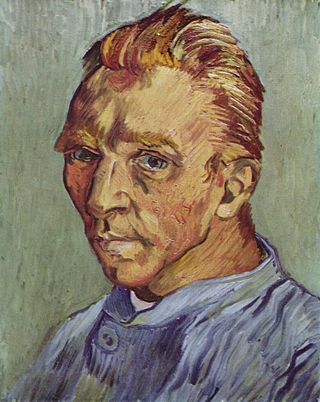
A self-portrait is a portrait of an artist made by themselves. Although self-portraits have been made since the earliest times, the practice of self-portraiture only gaining momentum in the Early Renaissance in the mid-15th century that artists can be frequently identified depicting themselves as either the main subject, or as important characters in their work. With better and cheaper mirrors, and the advent of the panel portrait, many painters, sculptors and printmakers tried some form of self-portraiture. Portrait of a Man in a Turban by Jan van Eyck of 1433 may well be the earliest known panel self-portrait. He painted a separate portrait of his wife, and he belonged to the social group that had begun to commission portraits, already more common among wealthy Netherlanders than south of the Alps. The genre is venerable, but not until the Renaissance, with increased wealth and interest in the individual as a subject, did it become truly popular.
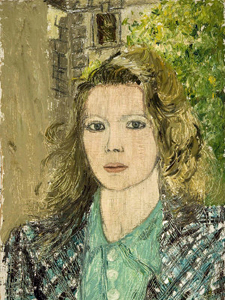
Sylvia Sleigh was a Welsh-born naturalised American realist painter who lived and worked in New York City. She is known for her role in the feminist art movement and especially for reversing traditional gender roles in her paintings of nude men, often using conventional female poses from historical paintings by male artists like Diego Vélazquez, Titian, and Jean-Auguste-Dominique Ingres. Her most well-known subjects were art critics, feminist artists, and her husband, Lawrence Alloway.
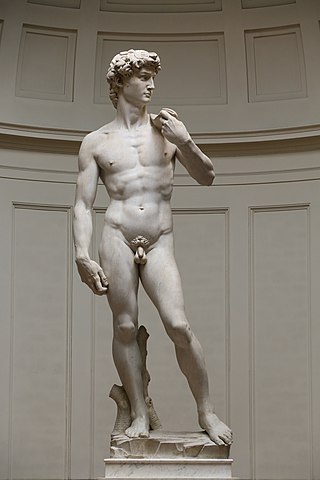
The nude, as a form of visual art that focuses on the unclothed human figure, is an enduring tradition in Western art. It was a preoccupation of Ancient Greek art, and after a semi-dormant period in the Middle Ages returned to a central position with the Renaissance. Unclothed figures often also play a part in other types of art, such as history painting, including allegorical and religious art, portraiture, or the decorative arts. From prehistory to the earliest civilizations, nude female figures were generally understood to be symbols of fertility or well-being.

What the Water Gave Me is an oil painting by Frida Kahlo that was completed in 1938. It is sometimes referred to as What I Saw in the Water.
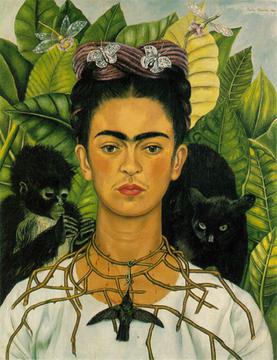
Self-Portrait with Thorn Necklace and Hummingbird is a 1940 self-portrait by Mexican painter Frida Kahlo which also includes a black cat, a monkey, and two dragonflies. It was painted after Kahlo's divorce from Diego Rivera and the end of her affair with photographer Nickolas Muray.

The Wounded Deer is an oil painting by Mexican artist Frida Kahlo created in 1946. It is also known as The Little Deer. Through The Wounded Deer, Kahlo shares her enduring physical and emotional suffering with her audience, as she did throughout her creative oeuvre. This painting in particular was created towards the end of Kahlo's life, when her health was in decline. Kahlo combines pre-Columbian, Buddhist, and Christian symbols to express her wide spectrum of influences and beliefs.
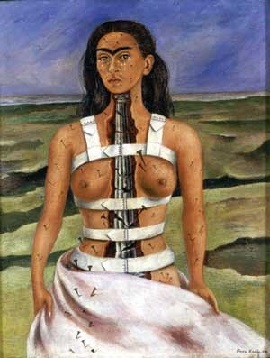
The Broken Column is an oil on masonite painting by Mexican artist Frida Kahlo, painted in 1944 shortly after she had spinal surgery to correct on-going problems which had resulted from a serious traffic accident when she was 18 years old. The original is housed at the Museo Dolores Olmedo in Xochimilco, Mexico City, Mexico.
Cynthia Mailman is an American painter and educator. She is known for figurative and landscape works done in a "cool, pared-down" style. Her early paintings were presented from a perspective inside the artist's VW van, looking outward, and include mirrors, wipers or other interior elements against the exterior landscape. By doing this, Mailman put the observer in the driver's seat, which is also the artist's point of view. According to Lawrence Alloway, "The interplay of directional movement and expanding space is a convincing expansion of the space of landscape painting".
Cristina Kahlo y Calderón was the sister of artist Frida Kahlo. Frida painted a portrait of Cristina, titled Portrait of Cristina, My Sister, and Diego Rivera, Frida's husband, also portrayed Cristina Kahlo in his work. Cristina, with whom Rivera had an affair, was painted by Rivera in the nude.

Two Nudes in a Forest is an oil painting by Mexican painter Frida Kahlo that was completed in 1939. It is also referred to as The Earth, Two Nudes in the Wood, or My Nurse and I. The painting was given to a close woman companion of Kahlo's, who some believe to be actress Dolores del Río. The two women in the painting also appear in Kahlo's 1938 painting What the Water Gave Me, and her spider monkey, which views the couple from the forest, also appears in Kahlo's 1937 Fulang-Chang and I.

Self-portrait in a Velvet Dress is a 1926 oil-on-canvas painting by Mexican artist Frida Kahlo.
References
- 1 2 Purvis, June (5 February 1999). "Reclaiming the self through art". Times Higher Education (THE). Retrieved 11 June 2018.
- ↑ "Borzello, Frances". OCLC World Cat. Retrieved 13 June 2018.
- ↑ Korda, Andrea (2017). Printing and Painting the News in Victorian London: "The Graphic and Social Realism, 1869-1891. Routledge. p. 14. ISBN 978-1351553247 – via Google Books.
- ↑ Borzello, Frances (1981). The relationship of fine art and the poor in late nineteenth century England (Thesis). Boston Spa, England: Document Supply Centre, British Library. OCLC 501940803.
- ↑ Kuhn, Annette (2017). The Power of the Image: Essays on Representation and Sexuality. Routledge. pp. 9–10. ISBN 978-1136137648.
- ↑ Deepwell, Kate (1995). New feminist art criticism: critical strategies. Manchester University Press. ISBN 9780719042577 – via Google Books.
- 1 2 3 Cooke, Rachel (11 April 2016). "Seeing Ourselves: from Boccaccio to the age of the selfie". the Guardian. Retrieved 13 June 2018.
- 1 2 Moore, Suzanne (4 April 1998). "Who does she think she is?". The Independent. Retrieved 11 June 2018.
- ↑ O'Sullivan, Niamh (9 January 1999). "Self-regard". The Irish Times. Retrieved 12 June 2018.
- ↑ "La Fridamanía toma la web: Así es la más grande retrospectiva digital sobre Frida Kahlo". La Nación, Grupo Nación (in Spanish). Retrieved 13 June 2018.
- ↑ "Sexy selfies through the ages". The Spectator. 26 March 2016. Retrieved 13 June 2018.
- ↑ Miranda, Carolina A. (14 July 2014). "Saving Frida Kahlo From Her Own Celebrity". ARTnews. Retrieved 13 June 2018.
- ↑ "Face to Face with Frida Kahlo, Judy Chicago, and Frances Borzello". Broad Strokes: The National Museum of Women in the Arts . 20 October 2010. Archived from the original on 6 November 2019. Retrieved 13 June 2018.
- ↑ Borzello, Frances (2 November 2002). "Nude awakening". The Guardian. Retrieved 13 June 2018.
- ↑ Auchmuty, Rosemary; Borzello, Frances; Davis Langdell, Cheri (1 January 1983). "The image of women's studies". Women's Studies International Forum. 6 (3). Elsevier: 291–298. doi:10.1016/0277-5395(83)90054-7. ISSN 0277-5395.
- ↑ "Tea, Toilets & Typewriters: Women's Clubs in London". History Today. 2008. Retrieved 11 June 2018.